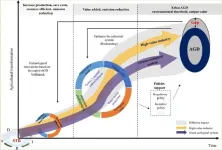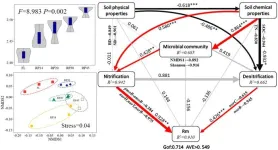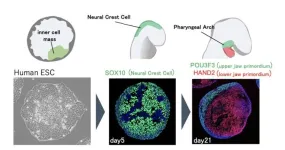Dynamic-EC: An efficient dynamic erasure coding method for permissioned blockchain systems
2024-04-12
(Press-News.org)
It's interesting to hear about the research led by Minyi Guo that was published in Frontiers of Computer Science on 12 Mar 2024. It seems like they are addressing the challenge of reducing storage overhead in blockchain systems while maintaining data consistency and tolerating malicious nodes.
In traditional blockchain networks, full replication is used, where each node stores a complete copy of all blocks, and data consistency is maintained through a consensus protocol. However, this approach can be storage-intensive, especially as the blockchain grows over time.
To address this issue, previous approaches like BFT-Store and Partition Chain have used erasure codes to store blocks more efficiently. Erasure coding allows for data to be broken into smaller fragments, with redundant parities added, and distributed across multiple nodes. This reduces storage requirements and can help tolerate node failures.
The research team's contribution appears to be in dynamically adjusting the encoding schema to tolerate malicious nodes more efficiently. They've observed that in typical cases, the number of malicious nodes is smaller than the threshold used for erasure coding. By dynamically adapting the encoding schema based on the actual number of malicious nodes, they aim to reduce unnecessary storage overhead associated with maintaining redundant parities to tolerate a larger number of malicious nodes than needed.
This research could have implications for improving the efficiency and scalability of blockchain networks, which is an important area of study as blockchain technology continues to evolve and find applications in various fields.
The team proposed a dynamic erasure coding method in permissioned blockchain systems called Dynamic-EC. The key idea of Dynamic-EC is to reduce the storage overhead by dynamically adjusting the total number of parities according to the risk level of the whole system, which is determined by the number of perceived malicious nodes, while ensuring the system reliability. Dynamic-EC can be divided into three modules: 1) Node Classification: this module is used to evaluate the global reputation value of each node. According to the reputation value, the nodes are classified into three categories: honest nodes, risk nodes and malicious nodes. 2) Dynamic Erasure Coding: this module is responsible for encoding the blocks into fragments and calculating the corresponding checksums in the leader node. The encoding schema is adaptively adjusted according to the current risk level of the system which is determined by the current number of risk nodes. 3) Adaptive Fragment Placement: this module distributes the encoded fragments from the leader node to the follower nodes.
END
ELSE PRESS RELEASES FROM THIS DATE:
2024-04-12
Erhai Lake, covering 252 km2, located in Yunnan Province, is one of the seven largest freshwater lakes in China. However, over the last three decades, the lake has suffered pollution episodes. In order to solve this problem, the local government has taken many protective measures. These measures have achieved some results in the environmental protection of Erhai Lake, but also caused significant socioeconomic impact. The tension between environmental preservation and economic stability in Erhai has even been termed the ‘Erhai dilemma’. The ‘Erhai dilemma’ is representative of those of other lakes in Yunnan Province ...
2024-04-12
Assessing the function of forest ecosystems requires a deep understanding of the mechanisms of soil nitrogen mineralization. A recent study conducted by a team of researchers has shed light on how soil N-cycling genes drive soil nitrogen mineralization during afforestation. The findings, published in the prestigious journal Soil Ecology Letters, provide valuable insights into the relationship between soil microbial communities, functional genes, and the rate of soil nitrogen mineralization.
The researchers collected soil samples from a chronosequence of Robinia pseudoacacia L (RP14, RP20, RP30, and RP45) at different stages of afforestation, along with a sloped farmland (FL) as ...
2024-04-12
Kyoto, Japan -- Mother Nature is an artist, but her craft of creating animal faces requires more than a paintbrush and palette. Such highly complex shapes originate from their respective transient neural crest cells.
These embryonic pluripotent cells within the facial primordium—the early development form—may be necessary for forming proper facial structures. However, analyzing the molecular mechanisms in such early stages of development poses many technical challenges.
Now, a group of Kyoto University researchers have produced neural crest cell-rich ...
2024-04-12
WASHINGTON (April 11, 2024) – Vosoritide’s first global phase 2 study showed an average increased growth rate of 1.8 cm per year in children with hypochondroplasia, a genetic cause of short stature in children, according to researchers from Children’s National Hospital.
“This is the first medicine that has been developed to specifically target the pathway involved in hypochondroplasia,” says Andrew Dauber, M.D., chief of Endocrinology at Children’s National. “These findings will help inform future studies of vosoritide for addressing growth disorders.”
This clinical trial ...
2024-04-12
Inside the brains of people with psychosis, two key systems are malfunctioning: a "filter" that directs attention toward important external events and internal thoughts, and a "predictor" composed of pathways that anticipate rewards.
Dysfunction of these systems makes it difficult to know what’s real, manifesting as hallucinations and delusions.
The findings come from a Stanford Medicine-led study, publishing April 11 in Molecular Psychiatry, that used brain scan data from children, teens and young adults with psychosis. The results confirm ...
2024-04-12
Megan Reiter, an assistant professor of physics and astronomy at Rice University, has won a National Science Foundation (NSF) CAREER Award to investigate the influence of neighboring stars on the formation of planets.
The research funded by Reiter’s five-year, $951,446 NSF grant will shed light on a phenomenon that could significantly impact our understanding of how planets are born.
“By exploring the intricate interplay between stars, planets and their environments, we hope to clarify the key forces that shape planet formation,” Reiter said.
Observations show planets form in the ...
2024-04-12
Join the International Society of Stem Cell Research (ISSCR) to celebrate Earth Day on 22 April 2024 by diving into the science of conservation, where the potential of stem cells is harnessed to foster a more sustainable and biodiverse future. This enlightening webinar co-hosted by Ashlee Hutchinson and Jun Wu will spotlight the revolutionary intersection of induced pluripotent stem cells (iPSCs), embryo models and genome engineering technologies with the noble cause of species preservation.
As our planet faces unprecedented biodiversity loss, this program will unveil how cutting-edge scientific advancements offer a lifeline for endangered species, ...
2024-04-12
NORMAN, OKLA. – Hanping Ding, Ph.D., an assistant professor in the School of Aerospace and Mechanical Engineering at the University of Oklahoma, has been awarded a $3.1 million grant from the Hydrogen and Fuel Cell Technologies Office in the Department of Energy through the Bipartisan Infrastructure Law to further research in clean hydrogen production. The funding is part of a $750 million effort in President Biden’s Investing in American agenda. The money from the Department of Energy will go to 52 projects across 24 states to position the United States as a global leader in the clean hydrogen industry.
The combined outcomes of the 52 projects should allow the ...
2024-04-12
Professor dr. Linda Amaral-Zettler, Research Leader at NIOZ Royal Netherlands Institute of Sea Research and the Chair in Marine Microbiology at the University of Amsterdam has been awarded a prestigious Advanced ERC-grant by the European Commission today. Amaral-Zettler receives almost 3,5 million euros for her research into biodegradation in the marine environment. “Biodegradable sounds really nice”, she admits. “But before we repeat the mistakes we’ve made with fossil-fuel-based plastics back in the last millenium, we really want to understand how these materials interact with marine life and how long they last in the environment.” “Biodegradable ...
2024-04-11
We depend on our cells being able to divide and multiply, whether it’s to replace sunburnt skin or replenish our blood supply and recover from injury. Chromosomes, which carry all of our genetic instructions, must be copied in a complete way during cell division. Telomeres, which cap the ends of chromosomes, play a critical role in this cell-renewal process—with a direct bearing on health and disease.
The enzyme telomerase plays a key role in maintaining the length of telomeres as chromosomes replicate during ...
LAST 30 PRESS RELEASES:
[Press-News.org] Dynamic-EC: An efficient dynamic erasure coding method for permissioned blockchain systems









